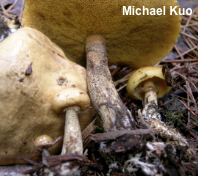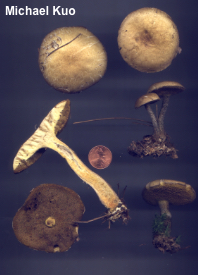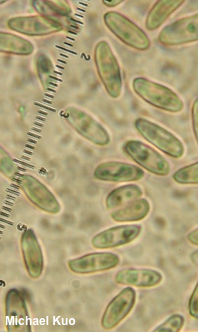| Major Groups > Boletes > Suillus > Suillus acidus |

|
[ Basidiomycota > Boletales > Suillaceae > Suillus . . . ] Suillus acidus by Michael Kuo, 18 October 2022 Suillus acidus is a fairly distinctive bolete featuring a whitish to dull yellow, slimy-when-fresh cap that often has partial veil remnants along its edge. The tough, skinny stem is adorned with glandular dots and a partially gelatinized, rolled ring that dries up and becomes a sheathing dark gray zone. The flesh in the stem is rosy orange, and the taste of the gluten on the fresh cap is acidic (hence the species epithet acidus). By current definitions (by which I mean Nguyen and collaborators 2016) Suillus acidus associates with both red pine and eastern white pine, which is not a bridge crossed by many species in the genus, and contains Suillus intermedius (previously separated on the basis of its cap color, which was never whitish when young), as well as Suillus lutescens and Suillus subolivaceus (the former with a lemon yellow stem base, appearing with eastern white pine; the latter with an olive-tinted cap, appearing in the Pacific Northwest with western white pine). Suillus subalutaceus, which is morphologically very similar but features a cap that becomes cinnamon brown with development and flesh that does not become pinkish orange in the stem, is phylogenetically separated, according to Nguyen. Description: Ecology: Mycorrhizal with red pine, eastern white pine, or western white pine; growing alone, scattered, or gregariously; late summer and fall; originally described from New York (Peck 1906); distributed in the northern Midwest, northeastern North America, and the Pacific Northwest. The illustrated and described collections are from Michigan. Cap: 3–12 cm; convex at first, becoming broadly convex; sticky to slimy when fresh; bald; pale yellow or nearly whitish when young, maturing to dull yellow or pale yellowish-brownish; often featuring white partial veil remnants on the margin. Pore Surface: Yellow, becoming brownish yellow; not bruising; pores angular, about 2–3 per mm; tubes to 7 mm deep. Stem: 3–10 cm long; 0.5–1 cm thick; tough; equal or slightly tapered to apex; yellow and bald toward the apex; whitish below, with pale to dark brown or black glandular dots; when fresh bruising pinkish near the base when handled; when young with a thin whitish ring that is often rolled and gelatinous at first; in age with a collapsed, appressed, whitish to grayish ring zone; basal mycelium white. Flesh: Whitish to yellowish in the cap; yellow in upper stem; pinkish orange in lower stem, especially near the base; staining slowly pinkish orange to brownish on exposure. Odor and Taste: Odor not distinctive; taste of flesh soapy-lemony; taste of cap slime (sorry) acrid. Chemical Reactions: Ammonia negative to grayish on cap surface; pink to reddish on white flesh; negative on orange flesh. KOH greenish gray to gray-brown on cap surface; bluish gray on white flesh; grayish on orange flesh. Iron salts negative on cap surface; negative or slightly gray on flesh. Spore Print: Cinnamon brown. Microscopic Features: Spores 8–12 x 2.5–3.5 µm; boletoid-fusiform; smooth; dull yellowish in KOH. Basidia 25–32 x 3–4 µm; clavate; 4-sterigmate. Cystidia in gelatinized bundles, often poorly defined individually; 40–60 x 4–7.5; cylindric to subclavate; thin-walled; smooth; brownish in KOH. Pileipellis a collapsing ixotrichoderm of elements 3–6 µm wide, smooth, dull golden in KOH; terminal cells cylindric with rounded apices. REFERENCES: (C. H. Peck, 1906) R. Singer, 1945. (Smith & Thiers, 1964; Snell & Dick, 1970; Smith & Thiers, 1971; Grund & Harrison, 1976; Smith, Smith & Weber, 1981; Phillips, 1991/2005; Both, 1993; Barron, 1999; Bessette, Roody & Bessette, 2000; Roody, 2003; McNeil, 2006; Kuo & Methven, 2014; Bessette, Roody & Bessette, 2016; Nguyen et al., 2016; Sturgeon, 2018.) Herb. Kuo 09019510, 09030203, 09150702. This site contains no information about the edibility or toxicity of mushrooms. |
© MushroomExpert.Com |
|
Cite this page as: Kuo, M. (2022, October). Suillus acidus. Retrieved from the MushroomExpert.Com Web site: http://www.mushroomexpert.com/suillus_acidus.html |


